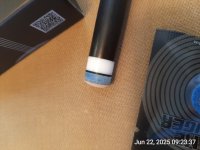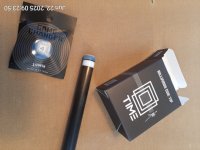Rhino 'Time' and 'Time Crystal' tips
- By NCC1515
- Pool Tables and Accessories Reviews
- 12 Replies
Had a teammate ask if I'd seen them so I looked them up. Searched on the web and here and couldn't find a review. Rhino is selling a tip made from layered "microfiber" cloth, in five hardnesses. Being a cloth and probably polyester (?), and available in multiple hardnesses, I would expect the binder might be polyurethane. If Rhino has a presence here, they can comment or not. They have a 'Time' and 'Time Crystal' tip and the only difference I see is that the 'Crystal' tip includes a clear pad underneath. No explanation if that clear pad is acrylic or polycarbonate. I'm not a fan of clear pads, and I favor harder tips, so I bought the 'Time' tips in medium hard, or #4. I have two CF shafts which are essentially the same, and they each had MH and H layered pigskin tips on them for almost a year now. Can't say the name because they are a product given for evaluation and I haven't seen the maker bring those tips to market - yet. Suffice to say: the evaluation tips installed and play as well as UltraSkins and I like them.
As for the Rhino Time tips: I replaced the MH tip on my 'home' shaft with a Rhino Time #4 and so far, it does everything the former MH tip did in terms of performance, so I can play all manner of shots as I normally do, including draw and extreme left or right spin, with no surprising results. Chalks easily and holds chalk well. An observation as an installer is: with my normal burnishing and finishing steps, I was unable to get any kind of 'shine' on the sides of the Time tip. So don't know how absorbent - or not - the edges of the layers are, since my assumption is that they are saturated with some aforementioned binder. Will the tip still be performing satisfactorily 6mo or 1yr from now? I guess 'time' will tell, although pricewise, they cost 3-4 times an UltraSkin.
As for the Rhino Time tips: I replaced the MH tip on my 'home' shaft with a Rhino Time #4 and so far, it does everything the former MH tip did in terms of performance, so I can play all manner of shots as I normally do, including draw and extreme left or right spin, with no surprising results. Chalks easily and holds chalk well. An observation as an installer is: with my normal burnishing and finishing steps, I was unable to get any kind of 'shine' on the sides of the Time tip. So don't know how absorbent - or not - the edges of the layers are, since my assumption is that they are saturated with some aforementioned binder. Will the tip still be performing satisfactorily 6mo or 1yr from now? I guess 'time' will tell, although pricewise, they cost 3-4 times an UltraSkin.

